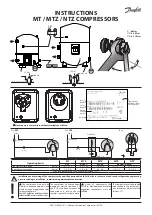
5 Testing & Troubleshooting
21
S T E P #
11
Using a multimeter, check for approximately 12V between the negative (-) terminal of
the battery [#2] and the YEL wire at each of the relay blocks. (i.e., the wire leading
directly from the pressure switch)
Was 12V detected?
YES
Proceed to STEP 12.
NO
Wiring fault between pressure switch and relay block. Replace wiring.
12
Disconnect the relay from the relay block. Using a multimeter, check the continuity
between the BLK wire at the relay block and the negative (-) terminal of the
battery [#2].
Did the resistance measure less than 1 Ohm?
YES
Reconnect the relay to the relay block. Proceed to STEP 13.
NO
Wiring fault in the ground wire between the battery and the relay block.
Replace wiring.
13
Using a multimeter, check for MOTOR VOLTAGE between the negative (-) terminal of
the battery [#1] and the RED-WHT wire connected to the relay block and while the
relay is still connected. Pierce the RED-WHT wire with the multimeter probe to make
connection if necessary.
Was MOTOR VOLTAGE detected?
YES
Proceed to STEP 14.
NO
Relay fault. Replace with a new 12V - 40A relay of the same type.
14
Disconnect the compressor motors from the wiring loom at the connector plug. Using
a multimeter, check for MOTOR VOLTAGE between the negative (-) terminal of the
battery [#1] and the RED-WHT wire on the loom side of the plug.
Was MOTOR VOLTAGE detected?
YES
Proceed to STEP 15.
NO
Wiring fault between the relay and the compressor motor connector. Replace wiring.
15
Using a multimeter, check the continuity (resistance) between the each of the BLK-
WHT wire on the loom side of the plug (not on the compressor side) and the negative
(-) terminal of the battery [#1].
Did the resistance measure less than 1 Ohm?
YES
Intermittent wiring fault or internal compressor problem. Contact ARB.
NO
Wiring fault in the ground wire between the battery [#1] and the compressor motor.
Replace wiring.




































